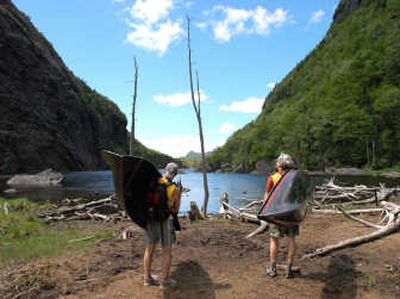Revival of the ultralight canoe

NORTH ELBA, N.Y. — Oncoming hikers stepped off the trail and made way for two canoes being hauled up to Avalanche Lake. It looked hard-core, or crazy, shouldering the boats 4.4 miles into the Adirondack High Peaks.
But at 12 pounds, the craft weighed less than a full backpack and were about one-fifth the weight of most canoes. “Cool,” one hiker said after hoisting a boat to test it.
Featherlights, as they are called, are lighter, smaller versions of the century-old Adirondack pack canoes that boat builders are marketing to those who want to paddle remote lakes, rivers and streams. Because they don’t weigh much, the solo canoes are also popular with women.
Dave Curtis, who sells replicas of 1880s solo canoes on the Internet, says the featherlights are little known outside New York.
“It’s a black art. For a long time there was very little information that was available,” said Peter Hornbeck, who estimates having made about 3,500 featherlights in two decades at his shop in Olmstedville. “Business is excellent. My business increased almost 25 percent last year.”
In part he credits interest generated by other boat builders who followed him, especially Placid Boatworks. Others include Curtis’ Hemlock Canoe Works in the Finger Lakes, Wisconsin-based Bell Canoe Works with its Bucktail, and Vermont Canoe’s Tupper. Prices start about $1,000.
Most of the solo boats weigh 20 to 25 pounds. In the water, the canoeist sits on the bottom, legs stretched, and uses a double-bladed paddle like a kayaker.
Each model has advantages. At just 12 pounds and 10 feet, 8 inches, Hornbeck’s carbon-Kevlar Black Jacks are the choice for a day with 11 miles of hiking and almost six of paddling.
For carries, the boats are hoisted over one shoulder, an arm is passed through the thwart, and the paddle is wedged inside.
“It’s a lot lighter than mine,” Susan Bibeau said after carrying a Black Jack across Marcy Dam. She had left her 16-pound Kevlar canoe at home.
“Lighter boats get blown around more,” Bibeau said. “They’re really more for pond hopping and rivers.”
An artist and photographer, she was thinking about buying another solo boat, Placid’s 12-foot, 23-pound SpitFire, to paddle New York’s Chubb, Osgood and Grasse rivers and enter a 90-mile race.
In the 1880s, George Washington Sears paddled small, light boats hundreds of miles in the central Adirondacks, memorializing the trips in Forest and Stream magazine. A series of boats, like the 9-foot Sairy Gamp now in the Smithsonian Institution, were made by the former Rushton Boat Works in Canton. They had “one-fool power in the middle,” Sears wrote.
“He was one of the many people who were pushing people to go back to nature without guides,” said Charlie Wilson, a partner in Placid Boatworks. But men were smaller then, and less likely to bring their Labrador retriever duck hunting. Even the lightest modern boats are bigger.
The builders also hope to make inroads on the market for kayaks, which have grown in popularity while interest in canoes has faded.
Hornbeck said kayaks, which he also makes, outsell canoes almost 8-to-1, he thinks partly because of the more efficient paddling technique. While most pack canoes use the same paddling technique, they’re are lighter than kayaks and don’t require having to stuff your gear in a compartment.
Placid, now in its fourth year, builds and sells 150 to 200 boats a year, Wilson said. It has four solo designs, two for sitting with a double-bladed paddle, two for kneeling with a single blade. A fully loaded SpitFire costs $2,295.
“When you want to build a boat light, you build it fragile or you build it expensive,” he said. “We’ve chosen the latter.”